#compact reactors
Explore tagged Tumblr posts
Text

Oklo says engaging with Nuclear Regulatory Commission in readiness assessment.. read more..
#oklo nuclear reactor#nuclear regulatory commission#small modular reactors#nuscale energy#nuclear energy solutions#energy problem solution#reactor decommissioning process#compact reactors#nuclear energy stocks#power agreement data center#nrc licensing tests#fatigue management nuclear sector#micro-reactors transportable#ufsar management#nrc social media stats#diablo canyon report errors#energy innovation nuclear#kairos power technology#nrc inspection programs#oklo stock analysis
0 notes
Text
"Like atoms coming together to release their power, fusion researchers worldwide are joining forces to solve the world's energy crisis. Harnessing the power of fusing plasma as a reliable energy source for the power grid is no easy task, requiring global contributions."
"Triangularity refers to the shape of the plasma relative to the tokamak. The cross section of the plasma in a tokamak is typically shaped like the capital letter D. When the straight part of the D faces the center of the tokamak, it is said to have positive triangularity. When the curved part of the plasma faces the center, the plasma has negative triangularity."
""It's a potential game changer with attractive fusion performance and power handling for future compact fusion reactors," he said. "Negative triangularity has a lower level of fluctuations inside the plasma, but it also has a larger divertor area to distribute the heat exhaust."
The spherical shape of SMART should make it better at confining the plasma than it would be if it were doughnut shaped. The shape matters significantly in terms of plasma confinement. That is why NSTX-U, PPPL's main fusion experiment, isn't squat like some other tokamaks: the rounder shape makes it easier to confine the plasma. SMART will be the first spherical tokamak to fully explore the potential of a particular plasma shape known as negative triangularity."
continue reading
#energy#nuclear fusion#nuclear energy#solar energy#plasma#plasma physics#nuclear power#tokamak#torus#sphere#charge#discharge#fusion reactors#compact fusion reactors#physics#science#global cooperation#energy evolution
3 notes
·
View notes
Text

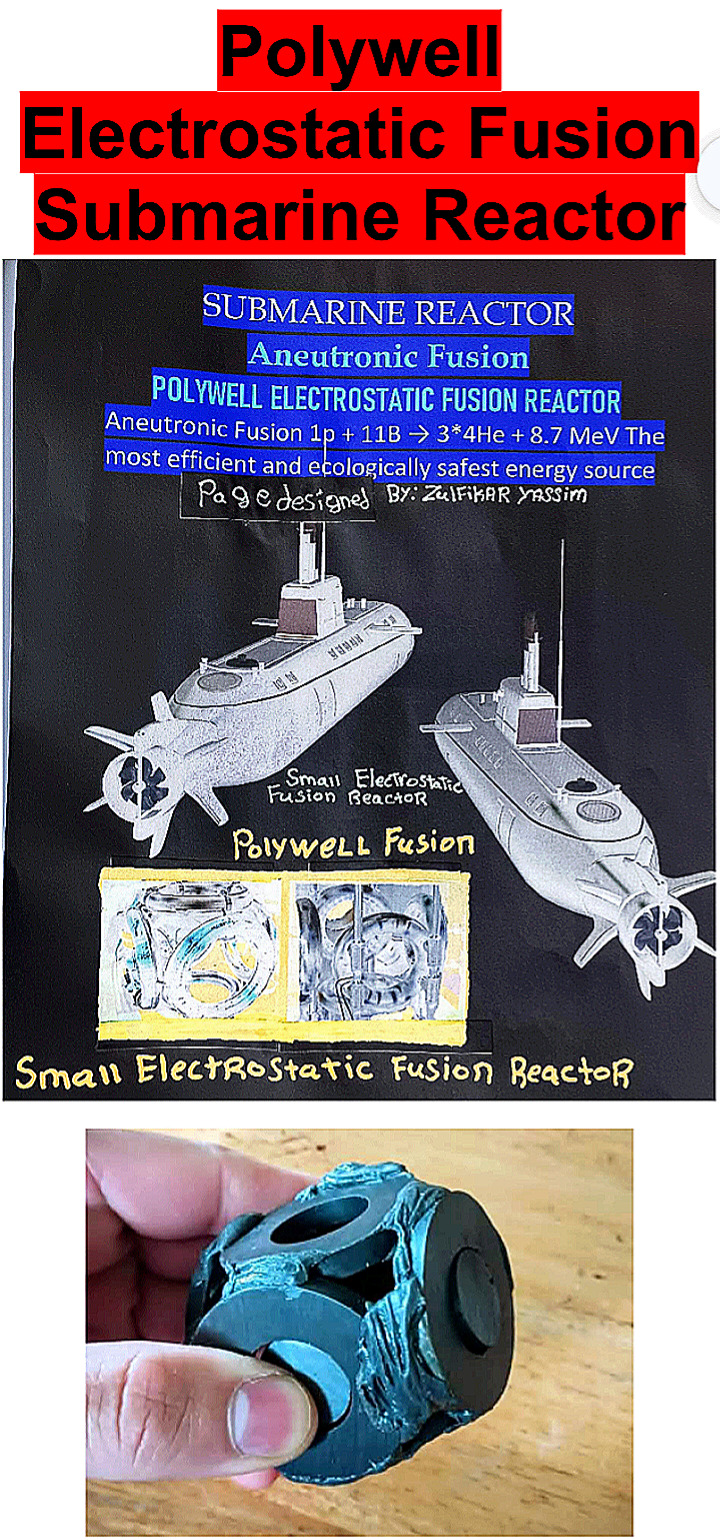
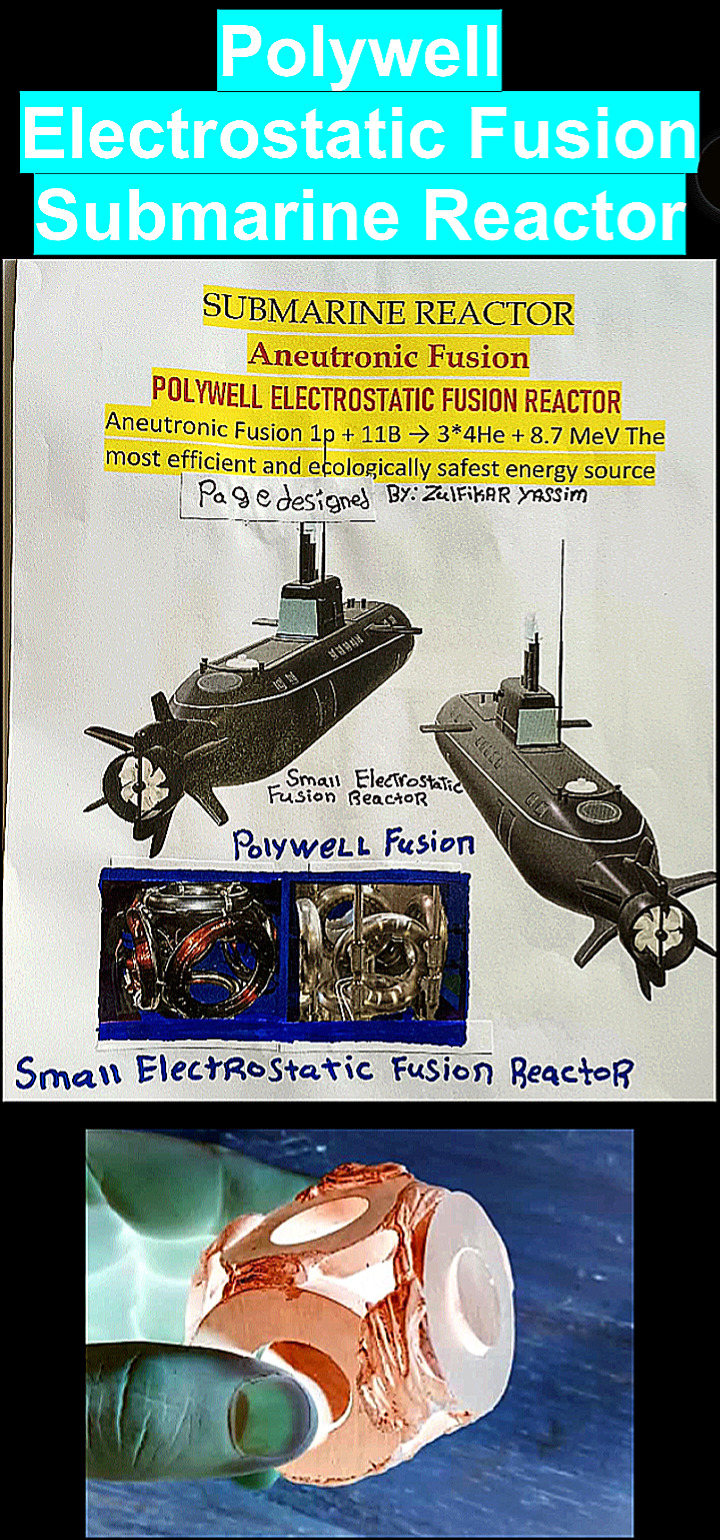

Zulfikar Yassim SMALL COMPACT POLYWELL ELECTROSTATIC FUSION SUBMARINE REACTOR
0 notes
Text
The Core Explodes
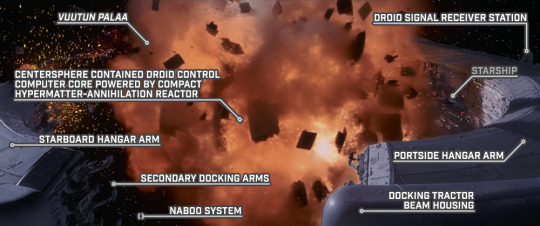
STAR WARS EPISODE I: The Phantom Menace 02:03:28
#Star Wars#Episode I#The Phantom Menace#Naboo system#Battle of Naboo#Vuutun Palaa#Droid Control Ship#Lucrehulk-class LH-3210#LH-1740 modular control core#centersphere#Droid Control Computer#compact hypermatter annihilation reactor#starboard hangar arm#secondary docking arms#droid signal receiver station#unidentified starship#portside hangar arm#docking tractor beam housing
0 notes
Text
Florets and You
The Hitchhiker's Guide to the Galaxy has knowledge and filings on many of our wonderful galaxy's strange and unique life forms and peoples. From the Vogons and theit revolting poetry, the Rinans with their fusion reactors, and humanity with their continued incompetence on the galactic stage. The galaxy is simply positively teeming with life.
Which is why it is so fascinating to approach the subject of florets when analyzing the Affini Compact. Whereas most components of the Compact can be best divided into "The Various Kinky Subjugated" and "The Kinky Plant Subjugators", the florets are something of a quandry to put into the scope of things as they fit into the most extreme end of the former. Rather than being a shorthand classification for affini below average height, a term that The Hitchhiker's Guide to the Galaxy has yet to find the existence of, the term "floret" refers to all of the pets the affini have subjugated regardless of species.
Florets enjoy a variety of delights from the affini, such as free access to any and all xenodrugs, head pats, and all the wild and kinky sex they could want. This is not to say independents and ferals do not enjoy such delights as well, but the florets get to do it even more whenever they want while wearing collars.
These sometimes poor and unfortunately happy souls are best defined by their loss of all rights in exchange for having a curious plant device grafted onto your spine to completely bind and subjugate you to whichever affini has decided you would look really cute in a pet bed beside their desk. This "spiney clingy friend," as it is known by former hitchhikers, provides the endless supply of drugs and regulates your body so that you can more effectively enjoy knowing only loving subjugation to your owner.
When traveling in Compact Space, it is in your best vested interest to know about florets and be aware of them. If you're in your ship or land transport, or the one belonging to the person you are borrowing it from, and someone yells "FLORET" please be mindful of whether there are florets in your path, and you must avoid them, as harming a floret is a good way to become one.
Conversely, if an affini is chasing them with a large smile, you should take that as a sign that you misheard them and that you actually need to "floor it."
Running from an affini is only advised if you want to be a floret. If you do desire this and try to run, make sure your back is ready for a plant to be embedded in it, you're ready to no longer to be a person, and your orifices are ready and primed for the incoming vines.
#hdg#human domestication guide#hdg shitposting#hdg writing#floretposting#affini#sophonts guide to the compact
105 notes
·
View notes
Text
Several groups representing “startup nations”—tech hubs exempt from the taxes and regulations that apply to the countries where they are located—are drafting Congressional legislation to create “freedom cities” in the US that would be similarly free from certain federal laws, WIRED has learned.
According to interviews and presentations viewed by WIRED, the goal of these cities would be to have places where anti-aging clinical trials, nuclear reactor startups, and building construction can proceed without having to get prior approval from agencies like the Food and Drug Administration, the Nuclear Regulatory Commission, and the Environmental Protection Agency.
Trey Goff, the chief of staff of the startup nation known as Próspera, tells WIRED that he and other Próspera representatives working under an advocacy group called the Freedom Cities Coalition have been meeting with the Trump administration about the idea in recent weeks. He claims the administration has been very receptive. In 2023, Trump floated the idea of creating 10 freedom cities. Now, Goff says that Próspera’s vision is to create “not just 10, but as many as the market can handle.” They hope to have drafted legislation ready by the end of the year.
“The energy in DC is absolutely electric,” Goff says. “You can tell in meetings with the people involved that they have the mandate to do some of the more hyperbolic, verbose things Trump has mentioned.”


Three Paths Forward
According to Goff, Freedom Cities Coalition has briefed White House officials on three options for creating freedom cities. One is through “interstate compacts.” In this scenario, two or more states could set aside territories with shared tax and regulation policies, with some state-specific carve-outs. Under existing law, these compacts can’t be revoked, though they can be dissolved under certain circumstances.
If an interstate compact is approved by Congress, it becomes valid under federal law. Goff says the coalition is considering Congressional legislation that would give “advanced consent” to any freedom city compacts. That way, Congress wouldn’t need to approve each individual city.
Two other options are creating federal enclaves with special economic and jurisdictional zones, or having Trump issue executive orders to create each new freedom city.
“It depends on what Trump and the White House want to do,” Goff says. “Whatever pathway they want to take, we want to help them make that a reality.”
The White House did not respond to a request for comment from WIRED.
A Network of Backers (and Detractors)
Freedom Cities Coalition was created by an entity called NeWay Capital LLC, which owns several trademarks for Próspera. Since opening on the Honduran island of Roatán in 2020, Próspera has been attracting tech workers and startups by promising low taxes, few regulations, and a businesslike government that considers its citizens to be akin to customers. Its financiers include Pronomos Capital, a venture capital firm backed by Peter Thiel and Marc Andreessen, and Coinbase.
Startup nations outside the US have largely relied on the creation of special economic zones (SEZs), where the regular rules governing businesses are waived, often in order to attract foreign investment. The hope, it appears, is to bring a similar model to the US.
Notably, the current government of Honduras considers Próspera and its special economic status to be illegal. The country’s previous president, Juan Orlando Hernández, gave Próspera a permanent charter to operate on its own terms. However, many Honduran citizens opposed Próspera, arguing that it has increased poverty and worsened biodiversity in the area. The Honduran Congress passed a law in 2022 repealing the allowance of SEZs, and Próspera sued the Honduran government shortly after. The lawsuit is ongoing.
President Donad Trump mentioned the idea of freedom cities on the campaign trail in March 2023. He promised that if he was elected president, he would hold a contest to pick 10 winners to build their own freedom cities on federal land. Trump hasn’t referred to the idea in public since, but Goff says he’s confident that it wasn’t a throwaway line from the president.
“It’s not just a marketing tactic—they take it very literally,” Goff adds, referring to members of Trump’s team. “They intend to follow through with all of the promises they made on the campaign trail.”
A Second Legislative Push
Freedom Cities Coalition isn’t the only group currently lobbying the Trump administration. Frontier Foundation, a 501c4 organization, is working in partnership with the nonprofit Charter Cities Institute to bring freedom cities to the US.
Jeffrey Mason, the head of policy at the Charter Cities Institute, tells WIRED that several other groups have recently joined their effort, including the Housing Center at the American Enterprise Institute and the Foundation for American Innovation. They’re drafting legislation that Mason says should be ready “hopefully sometime in the next several months.”
He adds that members of these groups are having “casual conversations with people in the White House,” in addition to Republican and Democratic members of Congress.
In a 2025 memo shared with WIRED, the Frontier Foundation argues that “domestic innovation and production has been significantly impeded for decades by outdated and unnecessarily restrictive federal regulation.”
Allen tells WIRED that using federal land would lower the cost of development for startup cities. The Frontier Foundation suggests that federally owned land outside western cities like Boise, Idaho; Grand Junction, Colorado; and Redmond, Oregon would be suitable candidates. “If we're able to get a legislative transfer of land from the US government to make a public-private partnership, or a trust, or even a private corporation, then it's a lower cost of capital,” he explains.
The Frontier Foundation memo also recommends allowing private landowners to become freedom cities and to “allow municipalities to vote to become Freedom Cities, allow Freedom Cities to expand with the consent of the contiguous land owners.”
When asked why the Freedom Cities movement has chosen not to focus on revitalizing existing post-industrial cities like Detroit or Toledo, Ohio, Allen tells WIRED that “when you're building these new facilities, you need to sort of start from scratch.” He noted that Joe Biden signed an executive order instructing the federal departments to lease federal lands to be used as data centers in the final days of his administration.
“There's so much capital and there's so much political will, but yet there's an inability to develop these technologies,” says Allen. “And the inability comes from lack of space and too many regulations.”
But Gil Duran, a former political consultant and author of the Substack newsletter Nerd Reich, warns that building new cities from scratch could have negative consequences. “To be outside of the law and above the law, what does that mean for the rest of the country?” he asks. “It seems like you're going to start hollowing out other places in order to have these places where the rules are suspended and don't apply anymore to certain people.”
Goff says that unlike Próspera, which has an entirely different tax structure from surrounding Honduras, freedom cities in the US would likely pay a similar amount in state and federal taxes as other American cities. The main difference would be how the cities are regulated.
American Dynamism
One company that stands to benefit from the rise of freedom cities is Minicircle, a longevity biotech company focused on developing gene therapies to extend human lifespans. The company’s seed funding came from Thiel and OpenAI CEO Sam Altman, and it currently has offices in both Austin, Texas, and Próspera. Minicircle cofounder Mac Davis is also working with the Frontier Foundation.
Davis says that Minicircle’s gene therapy clinical trial on the protein follistatin—which he claims increases muscle mass without side effects, and also has life-extending benefits in mice—was only possible in Próspera, but noted he’d like to see that change.
“I'd like a ‘longevity city’ where everyone and their dog is on gene therapy,” Davis says.
Davis adds that he can imagine many other companies benefiting from freedom cities, including SpaceX, the defense hardware and software company Anduril, and Oklo, a nuclear fission startup chaired by Sam Altman.
Many of the industries Allen says he hopes to foster in Freedom Cities–energy, nuclear, semiconductors, and defense technology–are, not coincidentally, ones “a lot of venture [capital] is going towards” as funding moves away from SaaS, digital, and internet consumer brands.
“The theme is American Dynamism,” he says, referencing the 2022 manifesto from venture capital firm Andreessen Horowitz, which argues that “the scientific and operational excellence of consequential technology companies made up for the shortfall of our flailing governmental institutions.” Since 2021, venture capitalists have plowed more than $100 billion into defense tech startups alone.
Some tech companies have been considering revitalizing nuclear power in order to sustain AI data centers, which use a huge amount of energy. Amazon signed several nuclear power agreements last year, Google made a deal with a nuclear power company in October 2024, and Meta is asking for proposals on how the company can leverage nuclear power.
Goff tells WIRED that he thinks freedom cities could also be used as manufacturing hubs and shipbuilding ports, allowing builders to bypass the environmental review process. Mason says the American Enterprise Institute, which is partnering with the Frontier Foundation and Charter Cities Institute, is eager to find ways to use freedom cities to increase housing.
Mason says he’s most excited about speeding up innovation in sectors like biotech and using nuclear power to power AI data centers.
“There's a lot of exciting opportunities here, especially as we need a lot of data centers,” Mason says. “There's a lot of land that you can tap.”
But Duran says that the same deregulation that could be seen as pro-business will likely not favor those outside Freedom Cities’ ultrawealthy backers. “These are going to be cities without democracy,” he claims. “These are going to be cities without workers' rights. These are going to be cities where the owners of the city, the corporations, the billionaires have all the power and everyone else has no power. That's what's so attractive about these sovereign entities to these people, is that they will actually be anti-freedom cities.”
55 notes
·
View notes
Text
Danganronpa 2: Goodbye Despair Characters + Loved Items















Full item list under the cut!
All information about Loved presents was taken from the Danganronpa wiki!
Teruteru Hanamura - 29) Passionate Glasses, 44) Kiss Note, 67) Kokeshi Dynamo
Mahiru Koizumi - 32) Silver Ring, 54) Kirlian Photography, 82) Japanese Tea Cup, 86) Century Potpourri, 102) Rose In Vitro, 107) Compact Costume
Nagito Komaeda - 33) Hope's Peak Ring, 90) Memory Notebook, 91) Mukuro's Knife
Fuyuhiko Kuzuryu - 71) Antique Doll, 81) Stardust
Ibuki Mioda - 46) 2.5D Headphones, 60) American Clacker, 75) Desperation, 83) Two-Sided Ukulele, 87) Absolute Tuning Fork
Chiaki Nanami - 41) Tips & Tips 2nd Edition, 62) Power Gauntlet, 64) Nitro Racer, 86) Century Potpourri, 102) Rose In Vitro, 103) Skullhead Mask
Sonia Nevermind - 11) Gugelhupf Cake, 21) Brightly Colored Jeans, 74) Another Battle, 86) Century Potpourri
Nekomaru Nidai - 19) Coconut, 24) Fresh Bindings, 42) Ogami Clan Codex, 89) Sand God's Storm Horn
Akane Owari - 8) Prepackaged Orzotto, 86) Century Potpourri
Peko Pekoyama - 22) Apron Dress, 71) Antique Doll, 79) Gold Coated Sheath, 86) Century Potpourri, 110) Secret Wind Sword Book
Hiyoko Saionji - 35) Cloth Wrap Backpack, 38) Biggest Fantom, 77) Paper "10th Act Verse", 86) Century Potpourri, 102) Rose In Vitro
Kazuichi Soda - 47) Radiosonde, 53) Lilienthal's Wings, 56) Small Degenerated Reactor, 70) Old Timey Radio, 92) Broken Warhead
Gundham Tanaka - 18) Sunflower Seeds, 31) Earring of Crushed Evil, 56) Small Degenerated Reactor, 108) Angel's Fruit
Byakuya Togami (Ultimate Imposter) - 9) Chocolate Chip Jerky, 13) Sweet Bun Bag, 17) Cocoshimi, 45) Black Rabbit Picture Book
Mikan Tsumiki - 25) Queen's Straitjacket, 55) Mr. Stapler, 109) Bandage Wrap
#once again i totally would've drawn these if i had any art skills#danganronpa#danganronpa 2#danganronpa 2 goodbye despair#danganronpa goodbye despair#teruteru hanamura#mahiru koizumi#nagito komaeda#fuyuhiko kuzuryu#ibuki mioda#chiaki nanami#sonia nevermind#nekomaru nidai#akane owari#peko pekoyama#hiyoko saionji#kazuichi soda#gundham tanaka#ultimate imposter#mikan tsumiki#danganronpa spoilers#danganronpa 2 spoilers#danganronpa 2 goodbye despair spoilers
76 notes
·
View notes
Text
MK 87 : CASE STUDY TYPE-TWO BLUEPRINT GENERATION.
Rough Material Work:

Finalized Version, Improved detail and Printing:
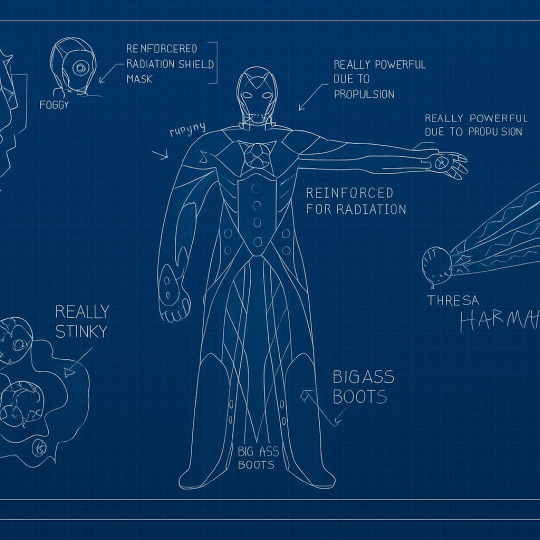
FINAL REPORT ON ANALYSIS OF PROOFED DESIGN
IRON MAN MK 87 SUIT — TECH REPORT
STARK INDUSTRIES INTERNAL REPORT
MODEL: Iron Man Armor MK 87
Filed by: @squiglesquid , R&D Division, Stark Tower.
Authorized by: A. Stark
Date: 18.06.2025
Design Summary:
The MK 87 is a next-gen Iron Man suit optimized for high-risk, high-radiation environments and deep-space or underwater missions. It combines durable defense systems with sleek Stark aesthetics — including a distinctive starburst arc reactor at the center chestplate.
Key Features & Upgrades:
Radiation Shielding:
Reinforced layers designed to withstand gamma bursts and solar radiation.
Respiratory Unit:
Recycled O₂ mask with internal filtration tubes; compact oxygen tank built into the spine plate.
Propulsion System:
Highly boosted thrusters embedded in "big-ass boots” and palms for rapid flight and maneuverability.
Star Pattern Design:
Arc reactor redesigned for stability and symmetry — also acts as a beacon for tracking in low-visibility zones.
Armor Composition:
Titanium-vibranium weave; impact-resistant, heat-dispersive, and light enough for agile combat.
Deployment:
Modular design for rapid assembly and compatibility with satellite upgrades.
Basic Stats:
Power Output: 600% above MK 85
Flight Ceiling: Orbital capable
Weight: 220 lbs
Combat Time: 72 hrs on full charge
Armor Integrity: Class X (military grade)
TAGGING ALL INTERNS AND PEOPLE THAT NEED TO GET WORKING ON THIS RESPECTIVE TO THEIR DIVISION: @sunny-the-intern @squiglesquid @oh-to-be-a-murderer @cursed-with-knowledge @of-spite-and-hatred @woodsparker-family @radioactiveintern @blackandgoldspiderwoman @lillian-the-intern @shortlikerdj @gamma-archivist @serenastark-official @project-traveler @that-fucker-elijah @playgirlgenius
Note: Test pilots report "really tanky but stylish as hell."
#tony stark#marvel#mcu#avengers#marvel cinematic universe#marvel movies#roleplay#roleplay blog#marvel comics#iron man
25 notes
·
View notes
Text
clemont: hey ash how small do you think a nuclear reactor could be compacted down to while still being functional?
ash: clemont. dude. it is 3 am save this idea for later please
*a few days later, at basically the same time*
ash: hey clemont
clemont: what?
ash: would you rather have to take on one gyarados sized torchic in a fight or 100 torchic sized gyarados in a fight?
clemont: ….ash it is too early for this.
#cameron’s rambles#pokemon#pokemon incorrect quotes#ash ketchum#clemont pokemon#pokemon anime#pokemon xy#pokemon xyz
78 notes
·
View notes
Text
"The Thallax were specialised, cybernetically-augmented shock troops manufactured and principally used by the Ordo Reductor of the ancient Mechanicum. The particular augmentations undergone by one of the Thallax are both severe and extreme, retaining only the brain (and in many cases the skull and spinal column), the life-sustaining viscera and nervous system as the basis of the articulated and armoured robotic frame which encompasses it. Other principal features of the design included a high-energy compact reactor system (whose emanations could not be endured by a less augmented organic system), allowing for extremely potent portable weaponry to be utilised, embedded Incunabulan Jet-Pack systems and arcane implanted sensory apparatus operating outside the usual realm of organic perception.
The sinister blank-faced helms of the Thalaxii conceal an array of inhuman sensory apparati through which they experience the battlefield as a raging storm of electromagnetic turmoil, blood-heat and seismic percussion. However, for the organic brain to handle this hurricane of data, it must be surgically mutilated, removing the mere Human senses such as sight and hearing. The unfortunate side-effects of these systems on the living components, however, were continuous agony and psychotic breakdown; effects ameliorated by the surgical excision of some of the brain's emotional centres. For some within the Mechanicum this transformation of the Human mind skirted the edge of abomination such as that posed by sentient "Abominable Intelligence"
The resulting machine-creature is capable of far greater tactical flexibility and independent action than a mere combat servitor, although terminal deterioration of the subject's psyche was certain over extended periods of time."
The 6 Thallax from the HH Mechanicum box, which I will be using as Kataphron Breachers in 40k. These lads are my favourite unit from the Mechanicum range, both in looks and lore and I forever hope and wish they get legend-ed in to 40k (never happening I know, but a trooper can dream). I shoved them onto some 60mm bases to avoid any "modeling for advantage" accusations and I'm pleasantly surprised by how ok they look on the larger base size, I was worried they'd look a bit weedy but I think they fill the space well (though I am very biased). They have some really cool extra gun options, with the Phased Plasma Fusil's, Photon Thrusters and Multi-Melta's, but not enough to fill a whole squad with. I dont want to muddy the proxy waters any further than I am already, so they're all getting the same, still very cool, Lightning Guns that I can pretend are Heavy Arc Rifles. So I'll keep the fancy ones for future kitbashing. Pic with Skit for Scale under the cut.

Also, hello to my Dark Heresy players, sorry that this is how you find out what that one character actually is, try not to worry too much about it :) .
33 notes
·
View notes
Text
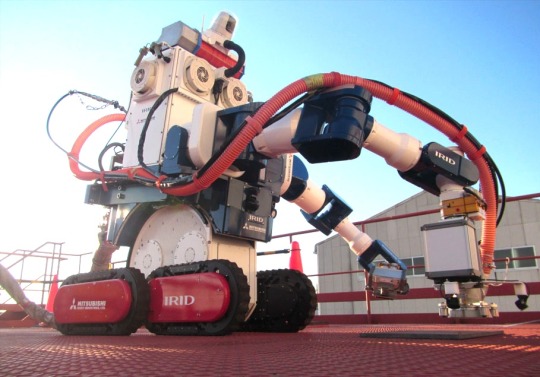



youtube
youtube
youtube
youtube
MEISTeR II (Maintenance Equipment Integrated System of Telecontrol Robot II), Mitsubishi Heavy Industries, Tokyo, Japan (2015). After the accident at Fukushima Daiichi Nuclear Power Plant in 2011, the interior of the reactor building is highly radioactive, and cannot be accessed by human workers. Remote controlled robots like MEISTeR II can carry out decontamination tasks using a range of specialised end-effectors. It can climb stairs, and it has a new "narrow space mode" that enables it to fold itself up into a compact form with a relatively tiny 85cm diameter footprint to navigate tight stairway landings. It even comes with its own decontamination train (second photo) for those stubborn radiological hazards.
60 notes
·
View notes
Note
So what's your take on the progress in fusion research? I've seen some people be really bullish on near-term commercial applications, especially with stellerators, but I'm always skeptical of industry hype.
In my own personal opinion, it's looking good. Like, really good. I will try to write up a longer post about this at some point but for now, it's stuff like this that makes me optimistic:
Magnets have always been a bottleneck for fusion. The reason ITER is so gigantic is because they're compensating for old-fashioned, relatively weak superconducting magnets with a massive plasma volume, which really sucks to build. But now we have hight-temperature superconductors (HTS), and it's only been in the past five or ten years that we've started to see real industrial quantities hit the market.
HTS magnets are much, much stronger. You can outstrip the performance of ITER with a fraction of the plasma volume. I personally believe it's likely that Commonwealth Fusion Systems will be first at bat with a compact HTS reactor, but the rest of the industry isn't far behind.
Obviously, magnets aren't the only challenge. But everything else gets so much easier when you can just make smaller magents.
35 notes
·
View notes
Text
Why Tousuke (Akechi x Kusuke)?
Akechi can beat Kusuo, and by extension, Kusuke, at many games, which gives Kusuke a new rival to focus on
Similar intelligence levels but in very different areas, so they can respect, admire, and actually learn from each other
Roughly same age (~2 years difference)
Kusuke can't lie to Akechi and Akechi doesn't lie, so they'd actually be able to communicate lol
Akechi has a strong moral compass so he'll #influence Kusuke towards fewer weapons of mass destruction
But also Akechi is a lunatic so he would think it perfectly cool and awesome that Kusuke made a cat with a hypodermic needle eye (such efficient packaging, you've managed to fit an enormous quantity of equipment into the compact and adorable body of this robotic feline– a sharp gaze indeed!)
Akechi & Kusuke collab on making assistive devices for Kusuo (without any built-in traps 🙄)
Kusuo, Kusuke, and Akechi all now get TWO playmates. What sorts of insane games will they play??
Akechi & Kusuke doing research on psychics together and helping the other characters discover/develop their powers
Akechi could probably get Kusuke to sleep more than 17 minutes a day or w/e lol.
Kusuke finally gets a real friend and cuddle buddy and maybe more...
They're both somewhere in the aromantic + asexual spectrums and Akechi would totally know how to figure out and navigate those feelings.
Akechi wouldn't be freaked out by Kusuke's bizarre fascinations and kinks or by his occasional need to lock himself in the lab and make something insane
Parallel play in the laboratory or Akechi helping Kusuke with experiments & builds <3 Akechi cooking real meals for Kusuke on occasion and often preparing fancy little desserts to share.
Completely insane date nights. Visits to advanced nuclear reactors. Jet pack excursions. Giant mech battles. Billionaire yacht party where someone gets coincidentally murdered and Akechi gets do a "whodunnit" for realsies. Stealing something out of a museum together. Kidnapping politicians who are making very bad decisions. Eating at both Michelin 3-star restaurants and holes-in-the-wall. Cheating casinos. Debating the morality of cannibalism until 4am. Tour of Europe. Fully immersive virtual reality games.
They PVP psychoanalyze each other for fun.
Most intimidating aura combo of all time. Local blond menaces.
They steal each other's clothes all the time and it becomes an increasingly elaborate game to add security measures to their closets. Until they accidentally end up obliterating each other's closets at the same and laugh and have to go shop for new clothes together.


[ Succumb to my propaganda... ]
#akechi touma#kusuke saiki#saiki kuusuke#kuusuke saiki#saiki kusuke#tousuke#saiki k#saiki no psi nan#sknpn#the disastrous life of saiki k.#tdlosk#they are so so so funny to me
174 notes
·
View notes
Text
"Mobile suits are powered by compact nuclear reactors"
Except for Chuchu's demi-trainer. That shit runs on the sheer power of her anger alone.
13 notes
·
View notes
Text
The Great Satisfactory State of Play April 2025 #3
Rocky Desert Phase 4 Factories
So we went to the Dune Desert to pay one last visit to Factory Town before it gets destroyed; we popped into the Northern Forest to visit the Phase 2 factories; and now we're about to zip into the Rocky Desert to have a gander at the Phase 3 rigmarole.

And here we are on the natural bridge that connects Northern Forest to Rocky Desert. In the distance, we can see several factories, two of which feed the reactor on the opposite side of the big rock tower. So we travel west, then up the slope...
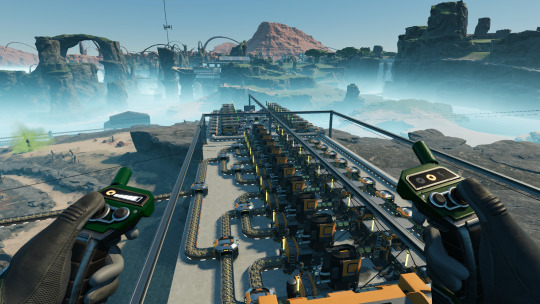
And here we have an open air silica and quickwire factory. The golden wire is crapped out in the foreground; silica is made down the back.
And where does the raw quartz come from to feed the machine? Well...

It comes from the bottom floor of the steelworks immediately below us, since the reactor doesn't use all that much silica, and I have more than enough being belted from deep within the immense cave that spans the entire width of this biome. It was a cinch to add a splitter and get that sorted!
Iron plate, silica, steel beams go out past the encased industrial beam factory in the distance, which adds much needed EIBs to the feed. Without these, the reactor stops hard.

An early WIP shot of the reactor. Obviously it's an uranium reactor, that also makes plutonium fuel rods for recycling. This was before I added the assemblers and manufacturers needed to finish that job. But that was then...

...this is now. The quickwire and silica are trained down this line to the far distant factory on the shoreline. But there's a factory closer, and newer, and it's the best example of my idea of the Stack. Shall we have a closer look?

That box in the foreground is from a mod, that allows you to tap power from train lines without needing a station. The modernist thing on the left is the caterium smeltery. That's all it does. So we skip that and hover along the power line to the skeletal one behind it. That's the Stack for electromagnetic control rods.

The idea of the Stack is simple. Each floor is dedicated to a single step in the manufacturing process. I tend to forget that because compactness. In the distant left, foundries and smelters feed copper and iron into the Stack.

Ground floor, iron and copper ingot arrival, copper sheet making. Please mind your step as getting bowled from stepping on the belts may offend (they're sent to one corner.) Going up.
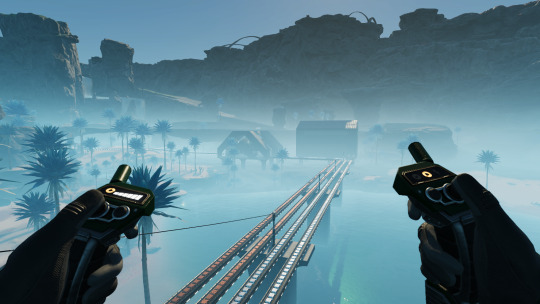
Belt bridge porn. Where was I? Oh yes.
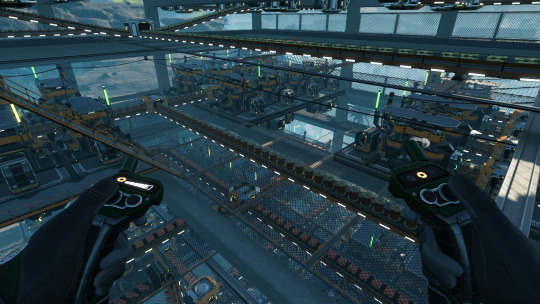
Second floor, copper wire. Note that my prefabs for 8 constructors are actually 4x4 rather than 5x5, which I use for the assemblers further up. Step to the rear of the car please.

Third floor, quickwire extrusion. This setup with the mesh flooring (from a mod) actually works quite well as it offers plenty of space for in- and output belting. Everybody up!
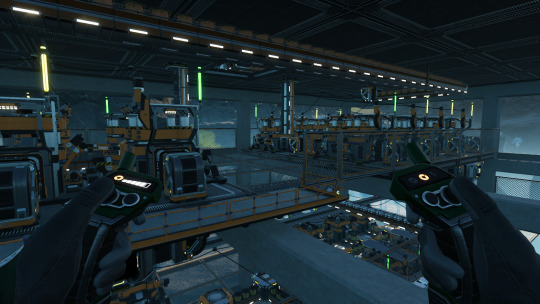
Fourth floor, iron pipe manufacture. With this half-floor we see one flaw of the Stack concept, if you consider empty floor space a flaw. And now we have to step outside the concrete pillar framework to look into the next floor up.
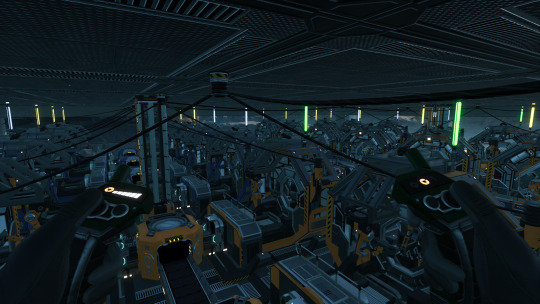
Fifth floor, AI limiters and stators. Yes, on the same floor, because it occurred to me that there was no logical reason to put them on separate floors. But now I wonder if another half-floor would have been so bad. Stators in back, AI limiters in front.

The prefabs include built-in logistics floors, and conveyor supports for the inputs, assuming everything, er, enters the same way. And those go up to...
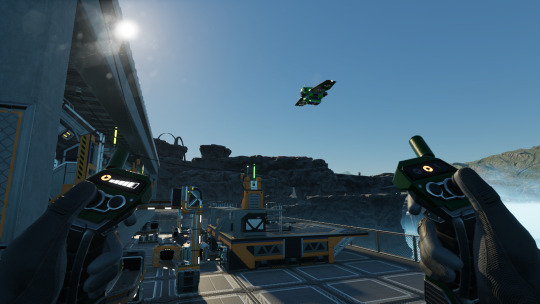
Top floor, ECR final join and dispatch. I have kluged up two drone ports at the reactor to receive these, and also supply said drones with fuel rods for plenty of power.
So that's my first true Stack! So what came before?
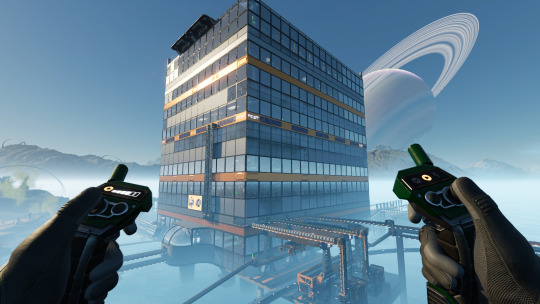
This is what came before: This damnable thick square building that makes parts for and does final join on modular engines and adaptive control units. On top are five drone ports. One receives fuel for the others. The two we can see receive smart plating and automated wiring. And there's that train station at the bottom of a rather entertaining ramp. Let's look inside.

Cool! We have a satellite HUB terminal (from a mod), and all other mod cons! Not to mention well-lit, at least in these lower floors, I skipped lighting as I went up and got impatient.
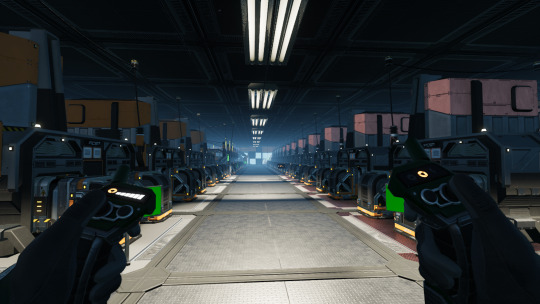
So many foundries and coated iron plate assemblers. Oh, and steel beam constructors.
I can't wait for the day when 1.1 is made mod friendly. This form of compact vertical transport is... well, it's not the going-up, it's the going-down. A 20m drop is hair-raising.

Silicon circuit boards and so, so many screws. There's about eight belts of them going up the south wall.

And this is where everything ends up: the roof. That building in the centre is where all the spaghet for dispatching the Phase 3 goods and receiving Phase 2 is. And dispensing fuel. And feeding the sink. While we're up here, let's look around:

So many miners! Copper, iron, limestone, it's all here and all getting exploited a mile into the ground.
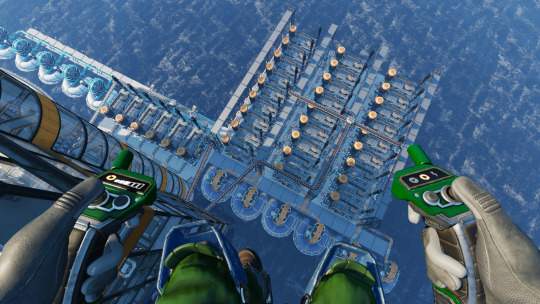
In back of the tower are the wet concrete refineries on the left, and the steamed copper sheet works. These were difficult to make, since I was, apparently, right on the edge of where I could place water extractors.
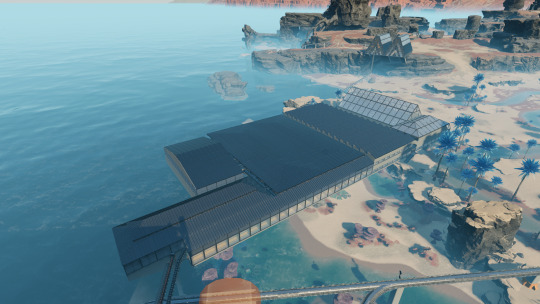
The mighty metal-roofed motor factory system! In the back, the double A-frame houses the solid steel ingot foundries; each different roofline indicates a separate stage of motor production. Copper ingots are belted in to a wire factory in the foreground.

The ground floor is marked with a coloured floor and path patterns, to highlight where you can walk from one end of Rocky Desert Motors to the other.

All of these constructors are making screws. All 64 of them. So. Many. Screws. If I didn't know any better, I'd think I was running Satisfactory+.
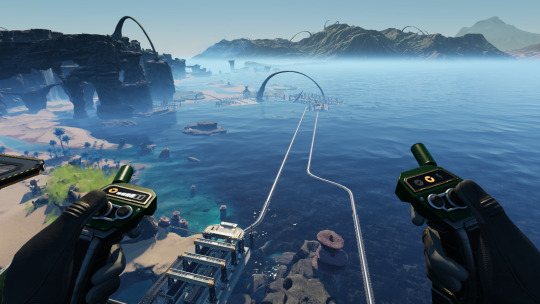
And here we have a distant shot of the abominations I made on the West Coast. There's a basic aluminium ingot factory, spagged to a hastily made heat sink factory and fuel packing plant, and also a massive refinery for making residual rubber and plastic to feed the tower. Coke, rubber and plastic are supplied by train, obviously. There's also a little fuel power plant that I really need to either redo or replace.
Actually this whole shebang desperately needs reworking. If I can rework the plant to make recycled rubber and plastic, that should improve output immensely.
Aaand that's where I am right now. In my pad of Warwick 14J5 I have a plan for a grid system that I can use to rebuild Factory Town... but first I have some more damned mining to do. I promised my passengers I'd have them in the North America Nebula by Easter.
Also, over Easter and possibly starting Wednesday, I'm going to reset Windows and see if that fixes the stability issues I've been having while streaming. Which means ensuring all my documents are backed up. So excuse me, I have to take my Type 8 Ye Olde Rock Thudder out to do just that...
2 notes
·
View notes
Text
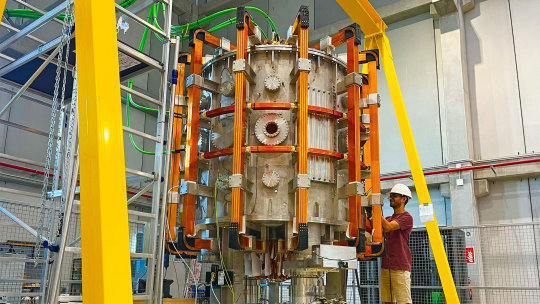
A new and unique fusion reactor comes together due to global research collaboration
Like atoms coming together to release their power, fusion researchers worldwide are joining forces to solve the world's energy crisis. Harnessing the power of fusing plasma as a reliable energy source for the power grid is no easy task, requiring global contributions.
The Princeton Plasma Physics Laboratory (PPPL) is leading several efforts on this front, including collaborating on the design and development of a new fusion device at the University of Seville in Spain. The SMall Aspect Ratio Tokamak (SMART) strongly benefits from PPPL computer codes as well as the Lab's expertise in magnetics and sensor systems.
"The SMART project is a great example of us all working together to solve the challenges presented by fusion and teaching the next generation what we have already learned," said Jack Berkery, PPPL's deputy director of research for the National Spherical Torus Experiment-Upgrade (NSTX-U) and principal investigator for the PPPL collaboration with SMART. "We have to all do this together or it's not going to happen."
Manuel Garcia-Munoz and Eleonora Viezzer, both professors at the Department of Atomic, Molecular and Nuclear Physics of the University of Seville as well as co-leaders of the Plasma Science and Fusion Technology Lab and the SMART tokamak project, said PPPL seemed like the ideal partner for their first tokamak experiment. The next step was deciding what kind of tokamak they should build.
"It needed to be one that a university could afford but also one that could make a unique contribution to the fusion landscape at the university scale," said Garcia-Munoz. "The idea was to put together technologies that were already established: a spherical tokamak and negative triangularity, making SMART the first of its kind. It turns out it was a fantastic idea."
SMART should offer easy-to-manage fusion plasma
Triangularity refers to the shape of the plasma relative to the tokamak. The cross section of the plasma in a tokamak is typically shaped like the capital letter D. When the straight part of the D faces the center of the tokamak, it is said to have positive triangularity. When the curved part of the plasma faces the center, the plasma has negative triangularity.
Garcia-Munoz said negative triangularity should offer enhanced performance because it can suppress instabilities that expel particles and energy from the plasma, preventing damage to the tokamak wall.
"It's a potential game changer with attractive fusion performance and power handling for future compact fusion reactors," he said. "Negative triangularity has a lower level of fluctuations inside the plasma, but it also has a larger divertor area to distribute the heat exhaust."
The spherical shape of SMART should make it better at confining the plasma than it would be if it were doughnut shaped. The shape matters significantly in terms of plasma confinement. That is why NSTX-U, PPPL's main fusion experiment, isn't squat like some other tokamaks: the rounder shape makes it easier to confine the plasma. SMART will be the first spherical tokamak to fully explore the potential of a particular plasma shape known as negative triangularity.
PPPL's expertise in computer codes proves essential
PPPL has a long history of leadership in spherical tokamak research. The University of Seville fusion team first contacted PPPL to implement SMART in TRANSP, a simulation software developed and maintained by the Lab. Dozens of facilities use TRANSP, including private ventures such as Tokamak Energy in England.
"PPPL is a world leader in many, many areas, including fusion simulation; TRANSP is a great example of their success," said Garcia-Munoz.
Mario Podesta, formerly of PPPL, was integral to helping the University of Seville determine the configuration of the neutral beams used for heating the plasma. That work culminated in a paper published in the journal Plasma Physics and Controlled Fusion.
Stanley Kaye, director of research for NSTX-U, is now working with Diego Jose Cruz-Zabala, EUROfusion Bernard Bigot Researcher Fellow, from the SMART team, using TRANSP "to determine the shaping coil currents necessary for attaining their design plasma shapes of positive triangularity and negative triangularity at different phases of operation." The first phase, Kaye said, will involve a "very basic" plasma. Phase two will have neutral beams heating the plasma.
Separately, other computer codes were used for assessing the stability of future SMART plasmas by Berkery, former undergraduate intern John Labbate, who is, now a grad student at Columbia University, and former University of Seville graduate student Jesús Domínguez-Palacios, who has now moved to an American company. A new paper in Nuclear Fusion by Domínguez-Palacios discusses this work.
Designing diagnostics for the long haul
The collaboration between SMART and PPPL also extended into and one of the Lab's core areas of expertise: diagnostics, which are devices with sensors to assess the plasma. Several such diagnostics are being designed by PPPL researchers. PPPL Physicists Manjit Kaur and Ahmed Diallo, together with Viezzer, are leading the design of the SMART's Thomson scattering diagnostic, for example.
This diagnostic will precisely measure the plasma electron temperature and density during fusion reactions, as detailed in a new paper published in the journal Review of Scientific Instruments. These measurements will be complemented with ion temperature, rotation and density measurements provided by diagnostics known as the charge exchange recombination spectroscopy suite developed by Alfonso Rodriguez-Gonzalez, graduate student at University of Seville, Cruz-Zabala and Viezzer.
"These diagnostics can run for decades, so when we design the system, we keep that in mind," said Kaur. When developing the designs, it was important the diagnostic can handle temperature ranges SMART might achieve in the next few decades and not just the initial, low values, she said.
Kaur designed the Thomson scattering diagnostic from the start of the project, selecting and procuring its different subparts, including the laser she felt best fits the job. She was thrilled to see how well the laser tests went when Gonzalo Jimenez and Viezzer sent her photos from Spain. The test involved setting up the laser on a bench and shooting it at a piece of special parchment that the researchers call "burn paper." If the laser is designed just right, the burn marks will be circular with relatively smooth edges.
"The initial laser test results were just gorgeous," she said. "Now, we eagerly await receiving other parts to get the diagnostic up and running."
James Clark, a PPPL research engineer whose doctoral thesis focused on Thomson scattering systems, was later brought on to work with Kaur. "I've been designing the laser path and related optics," Clark explained. In addition to working on the engineering side of the project, Clark has also helped with logistics, deciding how and when things should be delivered, installed and calibrated.
PPPL's Head of Advanced Projects Luis Delgado-Aparicio, together with Marie Skłodowska-Curie fellow Joaquin Galdon-Quiroga and University of Seville graduate student Jesus Salas-Barcenas, are leading efforts to add two other kinds of diagnostics to SMART: a multi-energy, soft X-ray (ME-SXR) diagnostic and spectrometers.
The ME-SXR will also measure the plasma's electron temperature and density but using a different approach than the Thomson scattering system. The ME-SXR will use sets of small electronic components called diodes to measure X-rays. Combined, the Thomson scattering diagnostic and the ME-SXR will comprehensively analyze the plasma's electron temperature and density.
By looking at the different frequencies of light inside the tokamak, the spectrometers can provide information about impurities in the plasma, such as oxygen, carbon and nitrogen. "We are using off-the-shelf spectrometers and designing some tools to put them in the machine, incorporating some fiber optics," Delgado-Aparicio said. Another new paper published in the Review of Scientific Instruments discusses the design of this diagnostic.
PPPL Research Physicist Stefano Munaretto worked on the magnetic diagnostic system for SMART with the field work led by University of Seville graduate student Fernando Puentes del Pozo Fernando.
"The diagnostic itself is pretty simple," said Munaretto. "It's just a wire wound around something. Most of the work involves optimizing the sensor's geometry by getting its size, shape and length correct, selecting where it should be located and all the signal conditioning and data analysis involved after that." The design of SMART's magnetics is detailed in a new paper also published in Review of Scientific Instruments.
Munaretto said working on SMART has been very fulfilling, with much of the team working on the magnetic diagnostics made up of young students with little previous experience in the field. "They are eager to learn, and they work a lot. I definitely see a bright future for them."
Delgado-Aparicio agreed. "I enjoyed quite a lot working with Manuel Garcia-Munoz, Eleonora Viezzer and all of the other very seasoned scientists and professors at the University of Seville, but what I enjoyed most was working with the very vibrant pool of students they have there," he said.
"They are brilliant and have helped me quite a bit in understanding the challenges that we have and how to move forward toward obtaining first plasmas."
Researchers at the University of Seville have already run a test in the tokamak, displaying the pink glow of argon when heated with microwaves. This process helps prepare the tokamak's inner walls for a far denser plasma contained at a higher pressure. While technically, that pink glow is from a plasma, it's at such a low pressure that the researchers don't consider it their real first tokamak plasma. Garcia-Munoz says that will likely happen in the fall of 2024.
IMAGE: SMall Aspect Ratio Tokamak (SMART) is being built at the University of Seville in Spain, in collaboration with Princeton Plasma Physics Laboratory. (Photo credit: University of Seville). Credit: University of SevilleL
4 notes
·
View notes